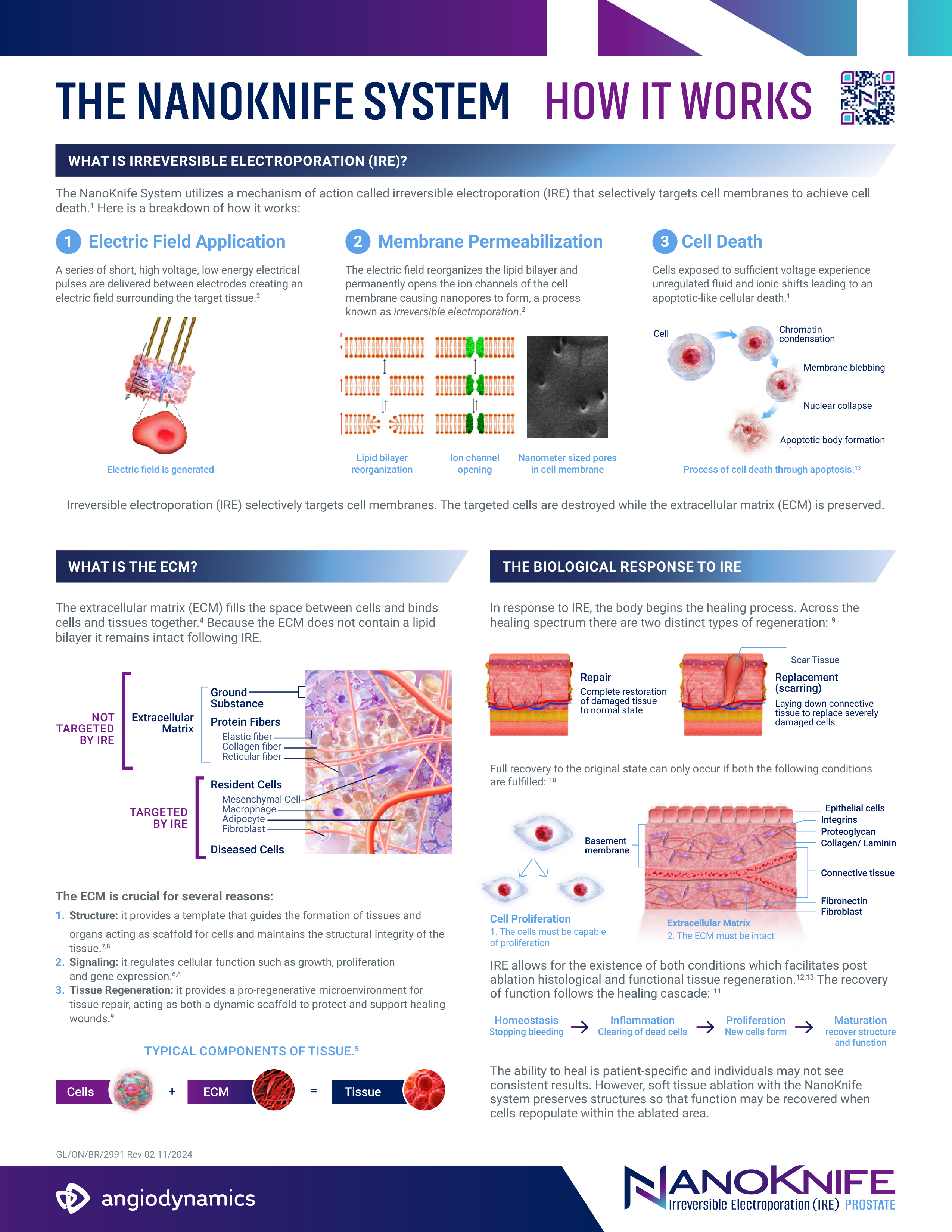納米刀局部治療前列腺癌
28 11 月 2023 2025-03-25 0:30Nanoknife Focal Therapy for Prostate Cancer

跨專業醫療團隊
跨專業醫療團隊,為局部前列腺癌提供局部治療、手術和放射治療。除了 前列腺癌精確診斷測試 ,我們還提供 經會陰前列腺活檢 (可點擊MRI 融合),用於局部治療的診斷和治療計劃
為您度身訂做的護理計劃
由我們專門的協調人員、泌尿外科醫生、磁力共振成像放射科醫生、內科專家和麻醉師團隊提供個人化的持續護理,以確保制定全面的患者治療計劃
全新和現代化的設施
致力提供最安全及最高品質的照護。我們也為省外和國際患者提供貴賓服務

什麼是納米刀療法?
納米刀療法的好處:
- RELIABLE ABLATION: Electrical pulses to destroy all living cells within the treatment area with no skip lesions
- GENEROUS MARGINS: Increased margin expansion without negatively impacting the rates of erectile function and incontinence in men.
- LESS COLLATERAL DAMAGE: Ability to ablate across the urethra, nerves, and urinary sphincters to ensure treatment of lesions near vital structures while preserving a patient’s quality of life.
- UNMATCHED VERSATILITY: Can treat all segments of the prostate, allowing physicians to build expertise in a single technology to optimize outcomes for patients.
- EASY INTEGRATION: Treatment typically takes one hour and seamlessly integrates into your practice utilizing existing imaging and biopsy skills.
- CONSERVE FUTURE OPTIONS: Procedures can be repeated if necessary and do not interfere with more standard treatments such as surgery or radiotherapy.
- 為局限性前列腺癌提供精確、個人化且可靠的治療替代方案
- 即時可視化和影像指導
- 保護負責泌尿和性功能的組織
- 微創短期門診手術,沒有手術傷口及無需住院
- 幾天後即可恢復正常活動
- 該程序可以重複,並且不排除未來其他治療選擇(如果需要)
The U.S. Food and Drug Administration (FDA) granted 510(k) clearance to the NanoKnife© System for prostate tissue ablation, specifically targeting intermediate-risk prostate cancer. This approval was based on the pivotal PRESERVE clinical study, which demonstrated that 84% of patients were free from clinically significant in-field disease 12 months post-procedure. Notably, the study reported strong quality-of-life outcomes, with urinary continence preserved in 95.4% of patients and a minimal decrease in erectile function.
This FDA clearance positions NanoKnife© as a promising, function-preserving treatment option for men with prostate tumors.
納米刀治療如何發揮作用?
The NanoKnife System uses electrical pulses delivered through thin needles to create openings in the walls of targeted prostate cells leading to their death. By preserving the other structures around the cells, it is more likely that urinary and erectile function will return.
Procedure Steps:
- Identify the tumor on MRI
- Bracket the tumor in probes
- Destroy cells with electric pulse

納米刀治療風險
- 術後幾天需使用導尿管
- 部份男病人可能會出現射精液減少或消失的情況
- 治療效果可能導致血尿或精液帶血
納米刀療法流程
手術前
詳細的專家諮詢,以判斷各種的前列腺癌治療方案和局部治療。
如有需要,評估可能包括多參數前列腺磁力共振和經會陰攝護腺切片檢查。
手術期間
手術在全身麻醉下進行,持續約 60 分鐘。在超音波引導下,將四到六個電極穿過陰囊後面的皮膚(會陰)放置到前列腺。
短脈衝電流依次在每個電極之間通過,從而能夠破壞相關的前列腺區域。
手術後
治療後,患者將在日間手術室接受觀察,然後帶著導尿管出院回家。
術後疼痛很少,出院時患者會根據需要使用抗生素、用於控制疼痛和膀胱痙攣的藥物。
根據治療的程度,留置導管兩到五天。
- 納米刀術後的長期追蹤監測將包括 PSA 測試、重複前列腺磁力共振和前列腺活檢。
常見問題
甚麼是前列腺癌?
前列腺是男性體內的一種核桃形小腺體,可產生滋養和運送精子的精液。前列腺癌的獨特之處在於許多前列腺腫瘤不會迅速擴散到身體的其他部位。即使在前列腺癌擴散的情況下,它通常也可以長期控制,使那些患有晚期前列腺癌的人能夠保持良好的健康和生活品質多年。治療前列腺癌的一個重要部分是監測其隨時間的增長。根據生長模式,您的醫生可以決定最佳的可用治療方案以及何時給予。
前列腺癌如何分級?
攝護腺癌的分級稱為格里森評分,這是最常用的攝護腺癌分級系統。此分數是根據在顯微鏡下觀察時癌症組織與健康組織的接近程度來計算的。侵襲性較低的癌性腫瘤看起來更像健康組織。而更具侵襲性的癌性腫瘤可能看起來與健康組織有很大不同。
病理學家在顯微鏡下觀察癌細胞並進行比較,他會觀察前列腺中的癌細胞,並以 3 到 5 的等級評分。看起來與健康細胞相似的癌細胞得分較低。看起來不太像健康細胞的癌細胞會獲得更高的分數。將這兩個分數相加得出格里森總分,分數在 6 到 10 之間。
What is focal therapy?
Focal therapy specifically targets prostate tumors as opposed to treating the entire gland.
How do I determine if the NanoKnife System is right for me?
Consult a specialist who has experience with the NanoKnife System. Ideal candidates have tumors visible in imaging that determine suitability for treatment.
Where is the NanoKnife System procedure performed?
Treatment can be performed at an ambulatory service center or a hospital. Consult with your doctor to decide which option is best for you.
How long is the procedure?
The treatment is typically an hour. Procedure time may vary based on your unique circumstances.
目前有哪些治療方案?
目前,前列腺癌患者有六種主要的治療選擇。包括:
積極監察
當前列腺癌未處於晚期或尚不需要立即治療時,建議進行積極監測。這涉及監測癌症是否有惡化的跡象。如果發現癌症惡化,則會開始更積極的治療,例如下面列出的治療。
手術
前列腺癌手術涉及切除前列腺和一些周圍的淋巴結。手術類型取決於疾病的階段、男性的整體健康狀況和其他因素。
放射治療
前列腺癌的放射治療是利用高能量射線來破壞癌細胞。放射治療方案或時間表由在一段時間內進行的特定次數的治療組成。
局部治療
局部療法被認為是侵入性較小的治療方法。它們可以摧毀小的前列腺腫瘤而不治療前列腺的其餘部分。這些治療可以使用不同形式的能量來破壞癌症,包括熱、冷或不可逆電穿孔。這種治療方式主要適用於中度風險前列腺癌患者。
全身性治療
全身性治療是使用藥物來消滅癌細胞。這種藥物會經由血流到達全身的癌細胞。全身性治療通常由腫瘤內科醫師(專門從事藥物治療癌症的醫師)開立處方。
睾酮抑制療法
這種治療形式的基礎是降低患者的睪固酮水平。由於前列腺癌的生長是由稱為雄激素的男性性激素驅動的,因此降低這些激素的水平可以幫助減緩癌症的生長。最常見的雄性激素是睪酮。體內睪固酮水平可以透過多種方式降低,包括手術切除睪丸或服用關閉睪丸功能的藥物。
How long does the catheter stay in?
Typically, 4 days. Catheter duration may be longer based on patient circumstances.
How long will the side effects last?
Side effects will typically last about 1-2 weeks. Actual side effects may be longer based on patient circumstances.
參考資料 :
- Cancer Facts & Statistics. American Cancer Society. https://cancerstatisticscenter.cancer.org/#!/cancer-site/Prostate. Published 2022. Accessed February 7, 2022
- Cancer Facts & Figures 2021. American Cancer Society. https://www.cancer.org/content/dam/cancer-org/research/cancer-facts-and-statistics/annual-cancer-facts-and figures/2021/cancer-facts-and-figures-2021.pdf. Accessed July 2021.
- Prostate Cancer. American Society of Clinical Oncology. Accessed November 2020 from https://www.cancer.net/cancer-types/prostate-cancer
- Data on file – Pivotal Study of the NanoKnife System for the Ablation of Prostate Tissue (PRESERVE)
Additional Patient Education Information, News & Testimonials
關於我們的位置
我們位於多倫多北部的中心位置,靠近安大略省列治文山的 7 號高速公路和 404 號高速公路,交通便利。
治療和諮詢以門診形式在全新的私人現代化診所環境中進行,診所設有易於使用的免費地下/地面停車場,可透過 VIVA 公共交通或汽車直接進入。我們毗鄰酒店設施(多倫多公園大道喜來登酒店、萬豪萬怡酒店和 Residence Inn 酒店以及希爾頓花園酒店),為外地患者及其家人提供服務。
我們的中心也完全適合殘疾人士使用。
地址
- 550 Hwy 7 Unit 317, Richmond Hill, ON L4B 3Z4
營業時間
- Mon-Fri 9:00AM - 5:00PM







